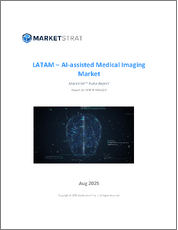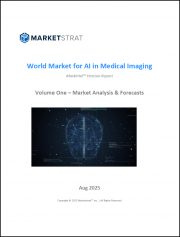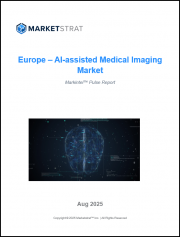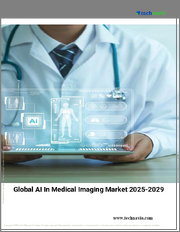
|
시장보고서
상품코드
1611332
세계의 로봇 의료 영상 시스템 시장 : 부문별 예측(2025-2030년)Robotic Medical Imaging Systems Market by Product (CT-Scan, MRI, Ultrasound), Application (Cardiology, Gastroenterology, Gynecology), End-User - Global Forecast 2025-2030 |
||||||
로봇 의료 영상 시스템(Robotic Medical Imaging Systems) 시장은 2023년에 191억 3,000만 달러로 평가되었고, 2024년에는 220억 6,000만 달러에 이를 것으로 추정되며, CAGR 16.22%로 추이하며 성장하여, 2030년에는 548억 2,000만 달러에 달할 것으로 예측됩니다.
로봇 의료 영상 시스템은 로봇 공학과 최첨단 영상 기술을 결합하여 진단의 정확성과 외과적 개입을 향상시키는 현대 의료의 혁신적인 발전을 나타냅니다. 이러한 시스템은 정확도를 높이고, 인적 오류를 줄이며, 최소 침습적 시술을 가능하게 하는 데 필수적인 역할을 합니다. 정밀도와 환자 안전이 가장 중요한 방사선과, 종양학, 심장학을 비롯한 다양한 의료 환경에서 활용되고 있습니다. 최종 사용 범위는 병원, 진단 센터 및 외래 수술 센터에 걸쳐 확장되어 의료 생태계 내에서의 폭넓은 수용을 반영합니다. 시장 인사이트에 따르면 인공지능의 발전, 진단 영상이 필요한 만성 질환의 유병률 증가, 최소 침습적 치료에 대한 수요 증가 등이 주요 성장 요인으로 꼽힙니다. 이 분야의 기회는 AI 기반 영상 분석에 대한 투자, 기술 기업과 의료 기관 간의 전략적 협업, 원격 의료의 적용 시나리오 확대로 확대되고 있습니다. 기업들은 개인화된 적응형 이미징 솔루션에 집중하고 클라우드 기반 이미징을 위한 파트너십을 구축하며 워크플로 최적화 기술에 투자함으로써 이러한 기회를 포착할 수 있습니다. 그러나 높은 비용, 상당한 초기 투자, 규제 장애물, 의료 전문가를 위한 전문 교육 필요성 등의 제약으로 인해 시장 성장이 제한되고 있습니다. 또한 데이터 보안과 상호운용성 문제도 지속적인 과제로 남아 있습니다. 이미지 해석 향상을 위한 AI 통합, 실시간 이미징 기능의 발전, 휴대용 및 무선 이미징 솔루션 개발 등의 혁신 분야가 무르익고 있습니다. 이러한 분야에 집중하면 비즈니스 성장과 경쟁력 강화에 도움이 될 수 있습니다. 이 시장은 빠른 기술 발전과 치열한 경쟁이 특징입니다. 리더십을 목표로 하는 기업은 기술 트렌드에 민첩하게 적응하고, 여러 부문 간의 협업을 촉진하며, 변화하는 규제 환경을 파악하여 이 역동적이고 유망한 시장 분야를 효과적으로 탐색해야 합니다.
| 주요 시장 통계 | |
|---|---|
| 기준연도(2023년) | 191억 3,000만 달러 |
| 추정연도(2024년) | 220억 6,000만 달러 |
| 예측연도(2030년) | 548억 2,000만 달러 |
| CAGR(%) | 16.22% |
시장 역학 : 빠르게 진화하는 로봇 의료 영상 시스템 시장 주요 인사이트 공개
로봇 의료 영상 시스템 시장은 수요 및 공급의 역동적인 상호 작용에 의해 변화를 겪고 있습니다. 이러한 변화하는 시장 역학을 이해하면 비즈니스 조직은 정보에 입각한 투자 결정을 내리고, 전략적 의사 결정을 개선하며, 새로운 기회를 포착할 수 있습니다. 이러한 트렌드를 종합적으로 파악함으로써 비즈니스 조직은 정치적, 지리적, 기술적, 사회적, 경제적 영역에서 다양한 위험을 완화하는 동시에 소비자 행동과 그것이 제조 비용 및 구매 트렌드에 미치는 영향을 더 명확하게 이해할 수 있습니다.
- 시장 성장 촉진요인
- 정확한 복강경 수술에 대한 수요 증가와 외상 비율 증가
- 세계의 만성질환의 유행
- 효율적인 의료 영상 시스템에 대한 수요 증가
- 시장 성장 억제요인
- 로봇 이미지 시스템과 관련된 높은 비용
- 시장 기회
- 로봇 의료 영상 시스템에서 기술 진보
- 1인당 건강 관리 지출 증가
- 시장 과제
- 로봇 의료 영상 시스템 설계의 복잡성
Porter's Five Force : 로봇 의료 영상 시스템 시장을 탐색하는 전략 도구
Porter's Five Force 프레임워크는 로봇 의료 영상 시스템 시장 경쟁 구도를 이해하는 중요한 도구입니다. Porter's Five Force 프레임워크는 기업의 경쟁력을 평가하고 전략적 기회를 탐구하는 명확한 기술을 제공합니다. 이 프레임워크는 기업이 시장 내 세력도를 평가하고 신규 사업의 수익성을 결정하는 데 도움이 됩니다. 이러한 통찰을 통해 기업은 자사의 강점을 활용하고, 약점을 해결하고, 잠재적인 과제를 피할 수 있으며, 보다 강인한 시장에서 포지셔닝을 보장할 수 있습니다.
PESTLE 분석 : 로봇 의료 영상 시스템 시장에서 외부로부터 영향 파악
외부 거시적 환경 요인은 로봇 의료 영상 시스템 시장의 성과 역학을 형성하는데 매우 중요한 역할을 합니다. 정치적, 경제적, 사회적, 기술적, 법적, 환경적 요인 분석은 이러한 영향을 탐색하는 데 필요한 정보를 제공합니다. PESTLE 요인을 조사함으로써 기업은 잠재적인 위험과 기회를 더 잘 이해할 수 있습니다. 이 분석을 통해 기업은 규제, 소비자 선호, 경제 동향의 변화를 예측하고 앞으로 예상되는 적극적인 의사 결정을 할 준비를 할 수 있습니다.
시장 점유율 분석 : 로봇 의료 영상 시스템 시장 경쟁 구도 파악
로봇 의료 영상 시스템 시장의 상세한 시장 점유율 분석을 통해 공급업체의 성과를 종합적으로 평가할 수 있습니다. 기업은 수익, 고객 기반, 성장률 등 주요 지표를 비교하여 경쟁 포지셔닝을 밝힐 수 있습니다. 이 분석을 통해 시장 집중, 단편화, 통합 동향을 밝혀내고 벤더들은 경쟁이 치열해지는 가운데 자사의 지위를 높이는 전략적 의사 결정을 내리는 데 필요한 지식을 얻을 수 있습니다.
FPNV 포지셔닝 매트릭스 : 로봇 의료 영상 시스템 시장에서 공급업체의 성과 평가
FPNV 포지셔닝 매트릭스는 로봇 의료 영상 시스템 시장에서 공급업체를 평가하는 중요한 도구입니다. 이 매트릭스를 통해 비즈니스 조직은 비즈니스 전략과 제품 만족도를 기준으로 벤더를 평가하여 목표에 부합하는 정확한 정보에 기반한 의사 결정을 내릴 수 있습니다. 4개의 사분면은 공급업체를 명확하고 정확하게 세분화하여 사용자가 전략적 목표에 가장 적합한 파트너와 솔루션을 식별할 수 있도록 도와줍니다.
전략 분석 및 제안 : 로봇 의료 영상 시스템 시장에서 성공을 위한 길을 그리기
로봇 의료 영상시스템 시장의 전략 분석은 전 세계 시장에서 입지 강화를 목표로 하는 기업에 필수적입니다. 주요 자원, 역량 및 성과 지표를 검토함으로써 기업은 성장 기회를 파악하고 개선을 위해 노력할 수 있습니다. 주요 리소스, 역량 및 성과 지표를 검토함으로써 비즈니스 조직은 성장 기회를 파악하고 개선을 위해 노력할 수 있습니다. 이러한 접근 방식은 기업이 경쟁 환경의 어려움을 헤쳐나가는 데 도움이 되며, 새로운 기회를 활용하고 장기적인 성공을 이끌어낼 수 있는 유리한 위치를 확보할 수 있도록 합니다.
이 보고서는 주요 관심 분야를 포괄하는 시장의 종합적인 분석을 제공합니다.
1. 시장 침투 : 현재 시장 환경의 상세한 검토, 주요 기업의 광범위한 데이터, 시장 도달범위 및 전반적인 영향력을 평가했습니다.
2. 시장 개척도 : 신흥 시장의 성장 기회를 파악하고 기존 분야의 확장 가능성을 평가하며 미래 성장을 위한 전략적 로드맵을 제공합니다.
3. 시장 다양화 : 최근 제품 출시, 미개척 지역, 산업 주요 진보, 시장을 형성하는 전략적 투자를 분석합니다.
4. 경쟁 평가 및 정보 : 경쟁 구도를 철저히 분석하여 시장 점유율, 사업 전략, 제품 포트폴리오, 인증, 규제 당국 승인, 특허 동향, 주요 기업의 기술 진보 등을 검증합니다.
5. 제품 개발 및 혁신 : 향후 시장 성장을 가속할 것으로 예상되는 최첨단 기술, R&D 활동, 제품 혁신을 강조합니다.
또한 이해관계자가 충분한 정보를 얻고 의사결정을 할 수 있도록 중요한 질문에 대답하고 있습니다.
1. 현재 시장 규모 및 향후 성장 예측은?
2. 최고의 투자 기회를 제공하는 제품, 부문 및 지역은?
3. 시장을 형성하는 주요 기술 동향과 규제의 영향은?
4. 주요 벤더의 시장 점유율과 경쟁 포지션은?
5. 벤더 시장 진입·철수 전략의 원동력이 되는 수익원 및 전략적 기회는?
목차
제1장 서문
제2장 조사 방법
제3장 주요 요약
제4장 시장 개요
제5장 시장 인사이트
- 시장 역학
- 성장 촉진요인
- 정확한 복강경 수술 수요 증가와 외상 비율 증가
- 만성 질환의 세계의 만연
- 효율적인 의료 영상 시스템에 대한 수요 증가
- 억제요인
- 로봇 이미지 시스템과 관련된 높은 비용
- 기회
- 로봇 의료 영상 시스템에서 기술 진보
- 1인당 헬스케어비 증가
- 과제
- 디자인의 복잡성 로봇 의료 영상 시스템
- 성장 촉진요인
- 시장 세분화 분석
- Porter's Five Forces 분석
- PESTEL 분석
- 정치적
- 경제적
- 사회적
- 기술적
- 법적
- 환경적
제6장 로봇 의료 영상 시스템 시장 : 제품별
- CT 스캔
- MRI
- 초음파
- X선
제7장 로봇 의료 영상 시스템 시장 : 용도별
- 심장병학
- 소화기 내과
- 부인과
- 신경학
- 종양학
- 정형외과
제8장 로봇 의료 영상 시스템 시장 : 최종 사용자별
- 진단센터
- 병원
제9장 아메리카의 로봇 의료 영상 시스템 시장
- 아르헨티나
- 브라질
- 캐나다
- 멕시코
- 미국
제10장 아시아 태평양의 로봇 의료 영상 시스템 시장
- 호주
- 중국
- 인도
- 인도네시아
- 일본
- 말레이시아
- 필리핀
- 싱가포르
- 한국
- 대만
- 태국
- 베트남
제11장 유럽·중동 및 아프리카의 로봇 의료 영상 시스템 시장
- 덴마크
- 이집트
- 핀란드
- 프랑스
- 독일
- 이스라엘
- 이탈리아
- 네덜란드
- 나이지리아
- 노르웨이
- 폴란드
- 카타르
- 러시아
- 사우디아라비아
- 남아프리카공화국
- 스페인
- 스웨덴
- 스위스
- 터키
- 아랍에미리트(UAE)
- 영국
제12장 경쟁 구도
- 시장 점유율 분석(2023년)
- FPNV 포지셔닝 매트릭스(2023년)
- 경쟁 시나리오 분석
- 전략 분석 및 제안
기업 목록
- AdEchoTech
- Digi Sens AG
- General Electric Company
- Globus Medical, Inc.
- Hitachi Ltd.
- Intuitive Surgical, Inc.
- Johnson & Johnson Services, Inc.
- Medirob AB
- Medtronic PLC
- MGI Tech Co., Ltd.
- Neocis Inc.
- Perfint Healthcare Corporation
- Renishaw PLC
- Siemens AG
- Stereotaxis, Inc.
The Robotic Medical Imaging Systems Market was valued at USD 19.13 billion in 2023, expected to reach USD 22.06 billion in 2024, and is projected to grow at a CAGR of 16.22%, to USD 54.82 billion by 2030.
Robotic Medical Imaging Systems represent a transformative advancement in modern healthcare, combining robotics and cutting-edge imaging technologies to enhance diagnostic precision and surgical interventions. These systems are instrumental in necessity for improving accuracy, reducing human error, and enabling minimally invasive procedures. They find application in diverse healthcare settings, including radiology, oncology, and cardiology, where precision and patient safety are paramount. The end-use scope extends across hospitals, diagnostic centers, and ambulatory surgical centers, reflecting a broadening embrace within the healthcare ecosystem. Market insights reveal that key growth influencers include advancements in artificial intelligence, increasing prevalence of chronic diseases necessitating diagnostic imaging, and the escalating demand for minimally invasive treatments. Opportunities in this sector are expanding with investments in AI-driven imaging analytics, strategic collaborations between tech companies and healthcare institutions, and expanding application scenarios in telemedicine. Firms can seize these opportunities by focusing on personalized and adaptive imaging solutions, fostering partnerships for cloud-based imaging, and investing in workflow optimization technologies. However, market growth is restrained by limitations like high costs, substantial initial investments, regulatory hurdles, and the need for specialized training for healthcare professionals. Additionally, data security and interoperability issues present ongoing challenges. Innovation areas ripe for exploration include AI integration for enhanced image interpretation, advancements in real-time imaging capabilities, and development of portable and wireless imaging solutions. Focusing on these areas can yield business growth and enhance competitiveness. The market is characterized by rapid technological evolution and strong competition. Companies aiming for leadership should prioritize agile adaptation to technology trends, foster collaborations across sectors, and remain attuned to changing regulatory landscapes to effectively navigate this dynamic and promising market sector.
| KEY MARKET STATISTICS | |
|---|---|
| Base Year [2023] | USD 19.13 billion |
| Estimated Year [2024] | USD 22.06 billion |
| Forecast Year [2030] | USD 54.82 billion |
| CAGR (%) | 16.22% |
Market Dynamics: Unveiling Key Market Insights in the Rapidly Evolving Robotic Medical Imaging Systems Market
The Robotic Medical Imaging Systems Market is undergoing transformative changes driven by a dynamic interplay of supply and demand factors. Understanding these evolving market dynamics prepares business organizations to make informed investment decisions, refine strategic decisions, and seize new opportunities. By gaining a comprehensive view of these trends, business organizations can mitigate various risks across political, geographic, technical, social, and economic domains while also gaining a clearer understanding of consumer behavior and its impact on manufacturing costs and purchasing trends.
- Market Drivers
- Rising demand for accurate laparoscopic surgeries and the increasing percentage of trauma injuries
- Prevalence of chronic disease worldwide
- Growing need for efficient medical imaging systems
- Market Restraints
- High costs associated with robotic imaging systems
- Market Opportunities
- Technological advancement in robotic medical imaging systems
- Rise in per capita healthcare spending
- Market Challenges
- Complexities in designing robotic medical imaging systems
Porter's Five Forces: A Strategic Tool for Navigating the Robotic Medical Imaging Systems Market
Porter's five forces framework is a critical tool for understanding the competitive landscape of the Robotic Medical Imaging Systems Market. It offers business organizations with a clear methodology for evaluating their competitive positioning and exploring strategic opportunities. This framework helps businesses assess the power dynamics within the market and determine the profitability of new ventures. With these insights, business organizations can leverage their strengths, address weaknesses, and avoid potential challenges, ensuring a more resilient market positioning.
PESTLE Analysis: Navigating External Influences in the Robotic Medical Imaging Systems Market
External macro-environmental factors play a pivotal role in shaping the performance dynamics of the Robotic Medical Imaging Systems Market. Political, Economic, Social, Technological, Legal, and Environmental factors analysis provides the necessary information to navigate these influences. By examining PESTLE factors, businesses can better understand potential risks and opportunities. This analysis enables business organizations to anticipate changes in regulations, consumer preferences, and economic trends, ensuring they are prepared to make proactive, forward-thinking decisions.
Market Share Analysis: Understanding the Competitive Landscape in the Robotic Medical Imaging Systems Market
A detailed market share analysis in the Robotic Medical Imaging Systems Market provides a comprehensive assessment of vendors' performance. Companies can identify their competitive positioning by comparing key metrics, including revenue, customer base, and growth rates. This analysis highlights market concentration, fragmentation, and trends in consolidation, offering vendors the insights required to make strategic decisions that enhance their position in an increasingly competitive landscape.
FPNV Positioning Matrix: Evaluating Vendors' Performance in the Robotic Medical Imaging Systems Market
The Forefront, Pathfinder, Niche, Vital (FPNV) Positioning Matrix is a critical tool for evaluating vendors within the Robotic Medical Imaging Systems Market. This matrix enables business organizations to make well-informed decisions that align with their goals by assessing vendors based on their business strategy and product satisfaction. The four quadrants provide a clear and precise segmentation of vendors, helping users identify the right partners and solutions that best fit their strategic objectives.
Strategy Analysis & Recommendation: Charting a Path to Success in the Robotic Medical Imaging Systems Market
A strategic analysis of the Robotic Medical Imaging Systems Market is essential for businesses looking to strengthen their global market presence. By reviewing key resources, capabilities, and performance indicators, business organizations can identify growth opportunities and work toward improvement. This approach helps businesses navigate challenges in the competitive landscape and ensures they are well-positioned to capitalize on newer opportunities and drive long-term success.
Key Company Profiles
The report delves into recent significant developments in the Robotic Medical Imaging Systems Market, highlighting leading vendors and their innovative profiles. These include AdEchoTech, Digi Sens AG, General Electric Company, Globus Medical, Inc., Hitachi Ltd., Intuitive Surgical, Inc., Johnson & Johnson Services, Inc., Medirob AB, Medtronic PLC, MGI Tech Co., Ltd., Neocis Inc., Perfint Healthcare Corporation, Renishaw PLC, Siemens AG, and Stereotaxis, Inc..
Market Segmentation & Coverage
This research report categorizes the Robotic Medical Imaging Systems Market to forecast the revenues and analyze trends in each of the following sub-markets:
- Based on Product, market is studied across CT-Scan, MRI, Ultrasound, and X-ray.
- Based on Application, market is studied across Cardiology, Gastroenterology, Gynecology, Neurology, Oncology, and Orthopedics.
- Based on End-User, market is studied across Diagnostic Centers and Hospitals.
- Based on Region, market is studied across Americas, Asia-Pacific, and Europe, Middle East & Africa. The Americas is further studied across Argentina, Brazil, Canada, Mexico, and United States. The United States is further studied across California, Florida, Illinois, New York, Ohio, Pennsylvania, and Texas. The Asia-Pacific is further studied across Australia, China, India, Indonesia, Japan, Malaysia, Philippines, Singapore, South Korea, Taiwan, Thailand, and Vietnam. The Europe, Middle East & Africa is further studied across Denmark, Egypt, Finland, France, Germany, Israel, Italy, Netherlands, Nigeria, Norway, Poland, Qatar, Russia, Saudi Arabia, South Africa, Spain, Sweden, Switzerland, Turkey, United Arab Emirates, and United Kingdom.
The report offers a comprehensive analysis of the market, covering key focus areas:
1. Market Penetration: A detailed review of the current market environment, including extensive data from top industry players, evaluating their market reach and overall influence.
2. Market Development: Identifies growth opportunities in emerging markets and assesses expansion potential in established sectors, providing a strategic roadmap for future growth.
3. Market Diversification: Analyzes recent product launches, untapped geographic regions, major industry advancements, and strategic investments reshaping the market.
4. Competitive Assessment & Intelligence: Provides a thorough analysis of the competitive landscape, examining market share, business strategies, product portfolios, certifications, regulatory approvals, patent trends, and technological advancements of key players.
5. Product Development & Innovation: Highlights cutting-edge technologies, R&D activities, and product innovations expected to drive future market growth.
The report also answers critical questions to aid stakeholders in making informed decisions:
1. What is the current market size, and what is the forecasted growth?
2. Which products, segments, and regions offer the best investment opportunities?
3. What are the key technology trends and regulatory influences shaping the market?
4. How do leading vendors rank in terms of market share and competitive positioning?
5. What revenue sources and strategic opportunities drive vendors' market entry or exit strategies?
Table of Contents
1. Preface
- 1.1. Objectives of the Study
- 1.2. Market Segmentation & Coverage
- 1.3. Years Considered for the Study
- 1.4. Currency & Pricing
- 1.5. Language
- 1.6. Stakeholders
2. Research Methodology
- 2.1. Define: Research Objective
- 2.2. Determine: Research Design
- 2.3. Prepare: Research Instrument
- 2.4. Collect: Data Source
- 2.5. Analyze: Data Interpretation
- 2.6. Formulate: Data Verification
- 2.7. Publish: Research Report
- 2.8. Repeat: Report Update
3. Executive Summary
4. Market Overview
5. Market Insights
- 5.1. Market Dynamics
- 5.1.1. Drivers
- 5.1.1.1. Rising demand for accurate laparoscopic surgeries and the increasing percentage of trauma injuries
- 5.1.1.2. Prevalence of chronic disease worldwide
- 5.1.1.3. Growing need for efficient medical imaging systems
- 5.1.2. Restraints
- 5.1.2.1. High costs associated with robotic imaging systems
- 5.1.3. Opportunities
- 5.1.3.1. Technological advancement in robotic medical imaging systems
- 5.1.3.2. Rise in per capita healthcare spending
- 5.1.4. Challenges
- 5.1.4.1. Complexities in designing robotic medical imaging systems
- 5.1.1. Drivers
- 5.2. Market Segmentation Analysis
- 5.3. Porter's Five Forces Analysis
- 5.3.1. Threat of New Entrants
- 5.3.2. Threat of Substitutes
- 5.3.3. Bargaining Power of Customers
- 5.3.4. Bargaining Power of Suppliers
- 5.3.5. Industry Rivalry
- 5.4. PESTLE Analysis
- 5.4.1. Political
- 5.4.2. Economic
- 5.4.3. Social
- 5.4.4. Technological
- 5.4.5. Legal
- 5.4.6. Environmental
6. Robotic Medical Imaging Systems Market, by Product
- 6.1. Introduction
- 6.2. CT-Scan
- 6.3. MRI
- 6.4. Ultrasound
- 6.5. X-ray
7. Robotic Medical Imaging Systems Market, by Application
- 7.1. Introduction
- 7.2. Cardiology
- 7.3. Gastroenterology
- 7.4. Gynecology
- 7.5. Neurology
- 7.6. Oncology
- 7.7. Orthopedics
8. Robotic Medical Imaging Systems Market, by End-User
- 8.1. Introduction
- 8.2. Diagnostic Centers
- 8.3. Hospitals
9. Americas Robotic Medical Imaging Systems Market
- 9.1. Introduction
- 9.2. Argentina
- 9.3. Brazil
- 9.4. Canada
- 9.5. Mexico
- 9.6. United States
10. Asia-Pacific Robotic Medical Imaging Systems Market
- 10.1. Introduction
- 10.2. Australia
- 10.3. China
- 10.4. India
- 10.5. Indonesia
- 10.6. Japan
- 10.7. Malaysia
- 10.8. Philippines
- 10.9. Singapore
- 10.10. South Korea
- 10.11. Taiwan
- 10.12. Thailand
- 10.13. Vietnam
11. Europe, Middle East & Africa Robotic Medical Imaging Systems Market
- 11.1. Introduction
- 11.2. Denmark
- 11.3. Egypt
- 11.4. Finland
- 11.5. France
- 11.6. Germany
- 11.7. Israel
- 11.8. Italy
- 11.9. Netherlands
- 11.10. Nigeria
- 11.11. Norway
- 11.12. Poland
- 11.13. Qatar
- 11.14. Russia
- 11.15. Saudi Arabia
- 11.16. South Africa
- 11.17. Spain
- 11.18. Sweden
- 11.19. Switzerland
- 11.20. Turkey
- 11.21. United Arab Emirates
- 11.22. United Kingdom
12. Competitive Landscape
- 12.1. Market Share Analysis, 2023
- 12.2. FPNV Positioning Matrix, 2023
- 12.3. Competitive Scenario Analysis
- 12.4. Strategy Analysis & Recommendation
Companies Mentioned
- 1. AdEchoTech
- 2. Digi Sens AG
- 3. General Electric Company
- 4. Globus Medical, Inc.
- 5. Hitachi Ltd.
- 6. Intuitive Surgical, Inc.
- 7. Johnson & Johnson Services, Inc.
- 8. Medirob AB
- 9. Medtronic PLC
- 10. MGI Tech Co., Ltd.
- 11. Neocis Inc.
- 12. Perfint Healthcare Corporation
- 13. Renishaw PLC
- 14. Siemens AG
- 15. Stereotaxis, Inc.



















